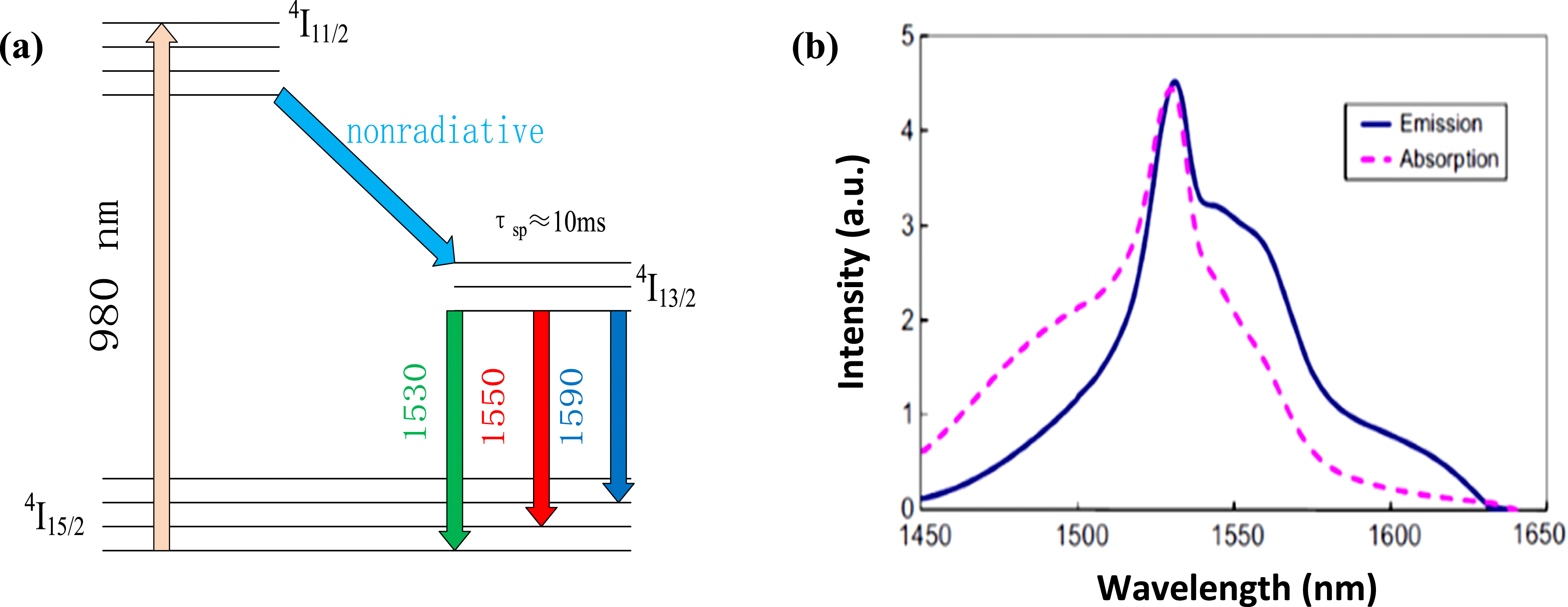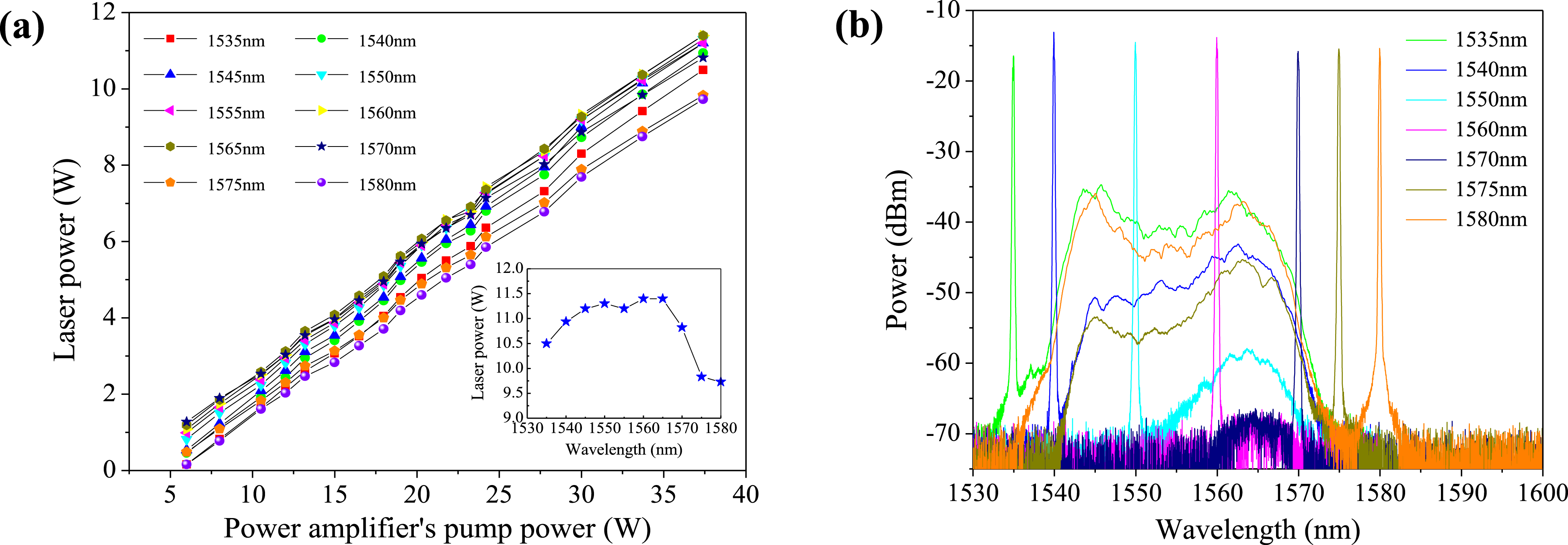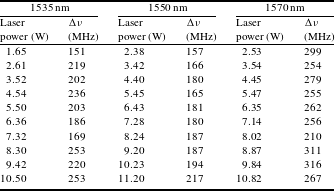1 Introduction
![]() $1.5~\unicode[STIX]{x03BC}\text{m}$
tunable narrow linewidth fiber laser sources have attracted considerable interest for their broad applications in optical communications, fiber sensors, coherent combination, fiber radar, and so on[Reference Koshikiya, Fan and Ito1–Reference Yu, Augst, Redmond, Goldizen, Murphy, Sanchez and Fan3]. Up to now, C-band single longitudinal mode fiber lasers of kHz-level linewidth have been achieved, while the output power is limited to the level of hundred mW[Reference Spiegelberg, Geng, Hu and Kaneda4–Reference Imrul and Rochette9]. High-power and narrow linewidth
$1.5~\unicode[STIX]{x03BC}\text{m}$
tunable narrow linewidth fiber laser sources have attracted considerable interest for their broad applications in optical communications, fiber sensors, coherent combination, fiber radar, and so on[Reference Koshikiya, Fan and Ito1–Reference Yu, Augst, Redmond, Goldizen, Murphy, Sanchez and Fan3]. Up to now, C-band single longitudinal mode fiber lasers of kHz-level linewidth have been achieved, while the output power is limited to the level of hundred mW[Reference Spiegelberg, Geng, Hu and Kaneda4–Reference Imrul and Rochette9]. High-power and narrow linewidth
![]() $1.5~\unicode[STIX]{x03BC}\text{m}$
fiber lasers are required in many applications, such as coherent combination, nonlinear frequency conversion, and optical parametric oscillation. In recent years, mid-infrared fiber gas lasers have attracted intensive attention[Reference Wang, Belardi, Yu, Wadsworth and Knight10–Reference Xu, Yu and Knight13], and the preferable pump sources are precisely tunable C-band fiber lasers with several hundreds of megahertz linewidth (matching the absorption linewidth of gas molecules such as
$1.5~\unicode[STIX]{x03BC}\text{m}$
fiber lasers are required in many applications, such as coherent combination, nonlinear frequency conversion, and optical parametric oscillation. In recent years, mid-infrared fiber gas lasers have attracted intensive attention[Reference Wang, Belardi, Yu, Wadsworth and Knight10–Reference Xu, Yu and Knight13], and the preferable pump sources are precisely tunable C-band fiber lasers with several hundreds of megahertz linewidth (matching the absorption linewidth of gas molecules such as
![]() $^{12}\text{C}_{2}\text{H}_{2}$
) and at least several hundreds of mW (the usual laser threshold). To the best of our knowledge, so far there are almost no such fiber lasers having been reported. Recently, we demonstrated a watt-level tunable
$^{12}\text{C}_{2}\text{H}_{2}$
) and at least several hundreds of mW (the usual laser threshold). To the best of our knowledge, so far there are almost no such fiber lasers having been reported. Recently, we demonstrated a watt-level tunable
![]() $1.5~\unicode[STIX]{x03BC}\text{m}$
narrow linewidth fiber ring laser using a temperature tuning
$1.5~\unicode[STIX]{x03BC}\text{m}$
narrow linewidth fiber ring laser using a temperature tuning
![]() $\unicode[STIX]{x1D70B}$
-phase shifted fiber Bragg grating, with maximum power of 1.1 W and linewidth of 318 MHz[Reference Sun, Wang, Wang, Zhou, Tang and Chen14]; however, the wavelength tuning range is only 1.29 nm, which cannot meet the requirements of tunable mid-infrared fiber gas lasers.
$\unicode[STIX]{x1D70B}$
-phase shifted fiber Bragg grating, with maximum power of 1.1 W and linewidth of 318 MHz[Reference Sun, Wang, Wang, Zhou, Tang and Chen14]; however, the wavelength tuning range is only 1.29 nm, which cannot meet the requirements of tunable mid-infrared fiber gas lasers.
In this paper, we characterize the properties of a high-power, wavelength tunable and narrow linewidth
![]() $1.5~\unicode[STIX]{x03BC}\text{m}$
band all-fiber laser amplifier, consisting of a precisely wavelength tunable diode laser, an Er-doped fiber pre-amplifier and an Er-Yb co-doped fiber (EYDF) power amplifier. The laser wavelength tunable range is from 1535 nm to 1580 nm, which covers many absorption lines of mid-infrared laser gases, such as
$1.5~\unicode[STIX]{x03BC}\text{m}$
band all-fiber laser amplifier, consisting of a precisely wavelength tunable diode laser, an Er-doped fiber pre-amplifier and an Er-Yb co-doped fiber (EYDF) power amplifier. The laser wavelength tunable range is from 1535 nm to 1580 nm, which covers many absorption lines of mid-infrared laser gases, such as
![]() $\text{C}_{2}\text{H}_{2}$
, HCN, CO, and HI. The maximum laser power is
$\text{C}_{2}\text{H}_{2}$
, HCN, CO, and HI. The maximum laser power is
![]() ${>}$
11 W, and the linewidth is about 200–300 MHz, which is close to the absorption linewidth of most gases at C-band. This work can provide preferable pump sources for fiber gas lasers based on hollow-core fibers[Reference Wang, Belardi, Yu, Wadsworth and Knight10–Reference Xu, Yu and Knight13].
${>}$
11 W, and the linewidth is about 200–300 MHz, which is close to the absorption linewidth of most gases at C-band. This work can provide preferable pump sources for fiber gas lasers based on hollow-core fibers[Reference Wang, Belardi, Yu, Wadsworth and Knight10–Reference Xu, Yu and Knight13].
2 Principle and experimental setup
The energy level scheme of the ground and first two excited states of Er ions in silica is shown in Figure 1(a). 980 nm LD works as the pump source to pump
![]() $\text{Er}^{3+}$
at the ground state
$\text{Er}^{3+}$
at the ground state
![]() $^{4}\text{I}_{15/2}$
to the excited state
$^{4}\text{I}_{15/2}$
to the excited state
![]() $^{4}\text{I}_{11/2}$
. Later,
$^{4}\text{I}_{11/2}$
. Later,
![]() $\text{Er}^{3+}$
backs to the semistable state
$\text{Er}^{3+}$
backs to the semistable state
![]() $^{4}\text{I}_{13/2}$
by nonradiative transition. Then the population inversion between the state
$^{4}\text{I}_{13/2}$
by nonradiative transition. Then the population inversion between the state
![]() $^{4}\text{I}_{13/2}$
and the ground state will be formed, which can realize the laser amplification over the range of 1530 nm to 1565 nm[Reference Zhou, Gao, Chen, Chen and Huo15]. Figure 1(b) shows the absorption and emission spectra of Er-doped fibers. It can be seen that the emission is weaker than the absorption before 1530 nm, while it becomes stronger after 1530 nm, and they are almost the same near 1530 nm, which mainly determines the characteristics of the laser output power at different wavelengths.
$^{4}\text{I}_{13/2}$
and the ground state will be formed, which can realize the laser amplification over the range of 1530 nm to 1565 nm[Reference Zhou, Gao, Chen, Chen and Huo15]. Figure 1(b) shows the absorption and emission spectra of Er-doped fibers. It can be seen that the emission is weaker than the absorption before 1530 nm, while it becomes stronger after 1530 nm, and they are almost the same near 1530 nm, which mainly determines the characteristics of the laser output power at different wavelengths.

Figure 1. (a) Energy level scheme of
![]() $\text{Er}^{3+}$
; (b) absorption and emission spectra of Er-doped fibers[Reference Sun, Wang, Wang, Zhou, Tang and Chen14].
$\text{Er}^{3+}$
; (b) absorption and emission spectra of Er-doped fibers[Reference Sun, Wang, Wang, Zhou, Tang and Chen14].
As shown in Figure 2, the amplifier consists of a precisely tunable
![]() $1.5~\unicode[STIX]{x03BC}\text{m}$
diode laser and two stages of fiber amplifiers. The wavelength tunable narrow linewidth continuous wave (CW) diode laser (made by ID Photonics, model of CoBrite DX1, linewidth
$1.5~\unicode[STIX]{x03BC}\text{m}$
diode laser and two stages of fiber amplifiers. The wavelength tunable narrow linewidth continuous wave (CW) diode laser (made by ID Photonics, model of CoBrite DX1, linewidth
![]() ${<}$
100 kHz, maximum output power
${<}$
100 kHz, maximum output power
![]() ${\sim}$
40 mW, tuning range 1527 nm to 1608 nm) is used as a seed laser. After an isolator (ISO), the seed laser and the pump laser (980 nm LD, single-mode fiber, 9 W) are injected into an 11-m long single-mode erbium-doped fiber by a wavelength division multiplexing (WDM) component. After the pre-amplifier stage, the seed power can reach a maximum power of
${\sim}$
40 mW, tuning range 1527 nm to 1608 nm) is used as a seed laser. After an isolator (ISO), the seed laser and the pump laser (980 nm LD, single-mode fiber, 9 W) are injected into an 11-m long single-mode erbium-doped fiber by a wavelength division multiplexing (WDM) component. After the pre-amplifier stage, the seed power can reach a maximum power of
![]() ${\sim}$
600 mW. The tunable filter located between the two stages is used to reduce the unnecessary amplified spontaneous emission (ASE), which can increase the percentage of signal light entering the power amplifier, consisting of a 9 m 12/130 EYDF, two high-power 980 nm diode lasers (total pump power
${\sim}$
600 mW. The tunable filter located between the two stages is used to reduce the unnecessary amplified spontaneous emission (ASE), which can increase the percentage of signal light entering the power amplifier, consisting of a 9 m 12/130 EYDF, two high-power 980 nm diode lasers (total pump power
![]() ${\sim}$
37.4 W) and a
${\sim}$
37.4 W) and a
![]() $(2+1)\times 1$
combiner. The final output laser power can reach
$(2+1)\times 1$
combiner. The final output laser power can reach
![]() ${>}$
10 W over the range of 1535 nm to 1570 nm, as shown in Figure 3(a).
${>}$
10 W over the range of 1535 nm to 1570 nm, as shown in Figure 3(a).

Figure 2. Experimental setup of the 10 watt-level narrow linewidth tunable
![]() $1.5~\unicode[STIX]{x03BC}\text{m}$
all-fiber amplifier. CW: continuous wave; ISO: isolator; WDM: wavelength division multiplexing; EDFC-980-HP: model of erbium-doped fibers; EYDF-12/130: model of erbium–ytterbium co-doped fibers, core diameter
$1.5~\unicode[STIX]{x03BC}\text{m}$
all-fiber amplifier. CW: continuous wave; ISO: isolator; WDM: wavelength division multiplexing; EDFC-980-HP: model of erbium-doped fibers; EYDF-12/130: model of erbium–ytterbium co-doped fibers, core diameter
![]() ${\sim}12~\unicode[STIX]{x03BC}\text{m}$
, cladding diameter
${\sim}12~\unicode[STIX]{x03BC}\text{m}$
, cladding diameter
![]() ${\sim}130~\unicode[STIX]{x03BC}\text{m}$
.
${\sim}130~\unicode[STIX]{x03BC}\text{m}$
.
3 Experimental results and discussion
The properties of the laser output power are shown in Figure 3(a). We can see that the laser power increases linearly with the pump power at different wavelengths, and the laser slope efficiency is about 30% with little change. As shown in the inset of Figure 3(a), the laser has the maximum output power over the range of 1545 nm to 1565 nm, which is about 11.2 W with a fluctuation of smaller than 0.2 W. And the output laser power will decrease when operating at both shorter and longer wavelengths, which is well in agreement with the absorption and emission properties of Er-doped fibers, as shown in Figure 1(b). Figure 3(b) shows the optical spectra of the laser amplifiers centered at 1535 nm, 1540 nm, 1550 nm, 1560 nm, 1570 nm, 1575 nm and 1580 nm with maximum pump power of 37.4 W. It can be seen that the signal light is significantly stronger than ASE, especially over the range of 1550 nm to 1570 nm, where the suppression of ASE is bigger than 45 dB, and the suppression ratio arrives at 55 dB from 1560 nm to 1570 nm. Although ASE will increase with the deviation of laser wavelength from this region, the ASE suppression ratio is still bigger than 20 dB even at 1535 nm and 1580 nm, which is useful for tunable mid-infrared fiber gas laser[Reference Hassan, Yu, Wadsworth and Knight11–Reference Xu, Yu and Knight13].
Figure 4 shows the output laser spectra, operating at different wavelengths and changing with the pump diode laser power of the second stage of the amplifier. We can see a common phenomenon that the ASE will increase with the increasing of the pump power except for 1560 nm and 1570 nm, where the ASE is about 55 dB lower than the signal laser. This is caused by the relatively high emission and low absorption at these wavelengths, as shown in Figure 1(b). For 1550 nm, as shown in Figure 4(b), the ASE is
![]() ${>}$
45 dB lower than the signal and changes little with the increasing of the pump power, which is also due to the relatively high emission and low absorption while the absorption is stronger than those of 1560 nm and 1570 nm. For 1540 nm, as shown in Figure 4(a), the ASE greatly increases and is still
${>}$
45 dB lower than the signal and changes little with the increasing of the pump power, which is also due to the relatively high emission and low absorption while the absorption is stronger than those of 1560 nm and 1570 nm. For 1540 nm, as shown in Figure 4(a), the ASE greatly increases and is still
![]() ${\sim}$
30 dB lower than the signal, which is due to the further increasing of absorption compared with 1550 nm, while changes little with the pump power. When operating at longer wavelengths, as shown in Figures 4(e) and 4(f), because of the low emission and low absorption, the ASE will sharply increase with the increasing of the pump power, and reach a relatively high level of
${\sim}$
30 dB lower than the signal, which is due to the further increasing of absorption compared with 1550 nm, while changes little with the pump power. When operating at longer wavelengths, as shown in Figures 4(e) and 4(f), because of the low emission and low absorption, the ASE will sharply increase with the increasing of the pump power, and reach a relatively high level of
![]() ${\sim}$
20 dB, lower than the signal for 1580 nm at the maximum pump power.
${\sim}$
20 dB, lower than the signal for 1580 nm at the maximum pump power.

Figure 3. (a) Evolutions of laser output power with the pump diode laser power of the second stage of the fiber amplifier at different wavelengths (inset: maximum laser power as a function of laser wavelength); (b) the optical spectra at different laser wavelengths with maximum pump power, measured using an optical spectral analyzer (OSA, Yokogawa, AQ6375B, spectra 1200–2400 nm) with scanning resolution of 0.05 nm.
Table 1. The evolution of the measured laser linewidth with the output power at different wavelengths.


Figure 4. The output laser spectra of different wavelengths as a function of different pump power of the power amplifier: (a)–(f) corresponding to center wavelengths of 1540 nm, 1550 nm, 1560 nm, 1570 nm, 1575 nm and 1580 nm, respectively.
Limited by the resolution of the optical spectral analyzer (OSA), the exact linewidth of the laser was measured using a scanning Fabry–Perot interferometer (Thorlabs, SA210-8B, free spectral range 10 GHz, resolution 67 MHz). The measuring setup is shown in Figure 5(a), and the recorded signal envelops when tuning the scanning voltage are shown in Figure 5(b), operating at 1550 nm with pump power of 15.8 W. Then the laser linewidth can be given by
where FSR is the free spectral range,
![]() $\unicode[STIX]{x0394}t$
is the full-width at half-maximum (FWHM) of the pulse signal envelop, and
$\unicode[STIX]{x0394}t$
is the full-width at half-maximum (FWHM) of the pulse signal envelop, and
![]() $\unicode[STIX]{x0394}T$
is the time distance of two adjacent pulse signal envelops.
$\unicode[STIX]{x0394}T$
is the time distance of two adjacent pulse signal envelops.

Figure 5. (a) Measurement setup for the laser linewidth using scanning Fabry–Perot interferometers; (b) the measured line shapes with pump power 15.8 W at center wavelength 1550 nm.
Table 1 shows the measured laser linewidth changing with the output laser power at 1535 nm, 1550 nm and 1570 nm. It can be seen that the linewidth changes between 150 MHz and 320 MHz with irregular fluctuations, in our opinion, which is mainly caused by the measuring errors due to the relatively low resolution of the Fabry–Perot interferometer. However, for a given wavelength, we still can find that the linewidth increases as the pump power rising if we neglect some singularity points, but the phenomenon is not obvious. The laser linewidth is smaller than the absorption spectrum width of most mid-infrared gases such as acetylene (
![]() $^{12}\text{C}_{2}\text{H}_{2}$
), whose linewidth is usually dominated by Doppler broadening to be
$^{12}\text{C}_{2}\text{H}_{2}$
), whose linewidth is usually dominated by Doppler broadening to be
![]() ${\sim}$
500 MHz at C-band (room temperature)[Reference Siegman16]. Meanwhile considering the ASE properties shown in Figures 3 and 4, the high-power narrow linewidth fiber amplifier described here can potentially enhance the whole power conversion efficiency of mid-infrared fiber acetylene lasers[Reference Xu, Yu and Knight13].
${\sim}$
500 MHz at C-band (room temperature)[Reference Siegman16]. Meanwhile considering the ASE properties shown in Figures 3 and 4, the high-power narrow linewidth fiber amplifier described here can potentially enhance the whole power conversion efficiency of mid-infrared fiber acetylene lasers[Reference Xu, Yu and Knight13].
4 Conclusions
In this paper, with the motivation to get a suitable high-power tunable narrow linewidth C-band pump source for mid-infrared fiber gas lasers, we constructed a 10 watt-level tunable fiber amplifier using a tunable narrow linewidth diode laser and two stages of Er-doped fiber amplifiers. The laser wavelength can be precisely tuned from 1535 nm to 1580 nm, which covers many absorption lines of mid-infrared laser gases, such as
![]() $\text{C}_{2}\text{H}_{2}$
, HCN, CO and HI. The maximum laser power is
$\text{C}_{2}\text{H}_{2}$
, HCN, CO and HI. The maximum laser power is
![]() ${>}$
11 W, the ASE is
${>}$
11 W, the ASE is
![]() ${>}$
20 dB lower than the signal over the whole tuning range, and the linewidth is about 200–300 MHz, which is close to the absorption linewidth of most mid-infrared gases. All these properties are very useful when being used as the pump source for high-power tunable mid-infrared fiber gas lasers based on low-loss hollow-core fibers.
${>}$
20 dB lower than the signal over the whole tuning range, and the linewidth is about 200–300 MHz, which is close to the absorption linewidth of most mid-infrared gases. All these properties are very useful when being used as the pump source for high-power tunable mid-infrared fiber gas lasers based on low-loss hollow-core fibers.
Acknowledgement
This work was supported by the National Natural Science Foundation of China (No. 11274385).












